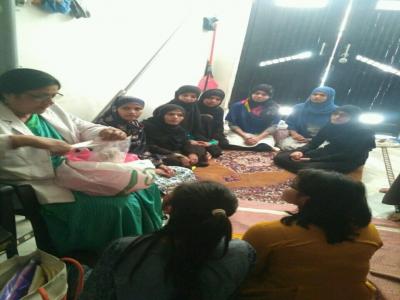Extension Activity - HUNAR,Bhatta Basti, Shastri Nagar

DEPARTMENT OF FASHION AND TEXTILES
The Department of Fashion & Textiles undertook a one day extension work on 27th march 2018 with the purpose of skill enhancement of underprivileged Basti women of Bhatta basti, Shastri Nagar and nearby areas who are associated with the organization HUNAR.
HUNAR is an enterprise of slum women in Jaipur with a focus on the issues of social security, employment and gender justice of deprived communities. HUNAR especially works to upgrade the skills of women so they can get an exposure to new designs, new fabrics, and new techniques and get right wages for their work.
The department organized a Batik Printing programme to help the organization in its noble cause.
A group of 11 students with 2 faculty members conducted a training session for the women on batik printing for the women to learn new technique of embellishment to help them in their creativity.
Batik is a technique of wax-resist dyeing applied to either whole cloth or by drawing dots and lines of the resist with a spouted tool or by printing the resist with a copper stamp called a cap. The applied wax resists dyes and therefore allows the artisan to color selectively by soaking the cloth in one color, removing the wax with boiling water, and repeating if multiple colours are desired. One of the significant features of this art is that it is very simple and can be done by anyone. Colorful batik prints grace the home furnishings with elegance and style. Beautiful bags, household linens, murals and wall paintings with striking batik works enjoy a great demand in the domestic and international market.
The students started the demonstration with general introduction on the technique as well as on the process for application of resist. The ratios and quantities of the different wax was shown the ladies and the process for melting the three types of wax thus commenced. The ladies were then demonstrated different methods of application which involved all over application, spraying, block and free hand motifs. The ladies were given small fabric samples to create their own design and patterns of their choosing.
After application of wax, dyeing of the samples and stoles was demonstrated using Azo-dyes, which included the naphthalation process and dying process. Two color dyeing was also demonstrated to help them create variations in designs.
After the dyeing process the samples were dried in shade followed by de-waxing of the samples.
The different techniques used for de-waxing were demonstrated to reveal the designs that were created using batik printing technique.
Dr. Radha Kashyap Teacher Co-ordinator
Head, Department of Fashion & Textiles Ms. Aditi singh
Ms. Sunetra Datt

